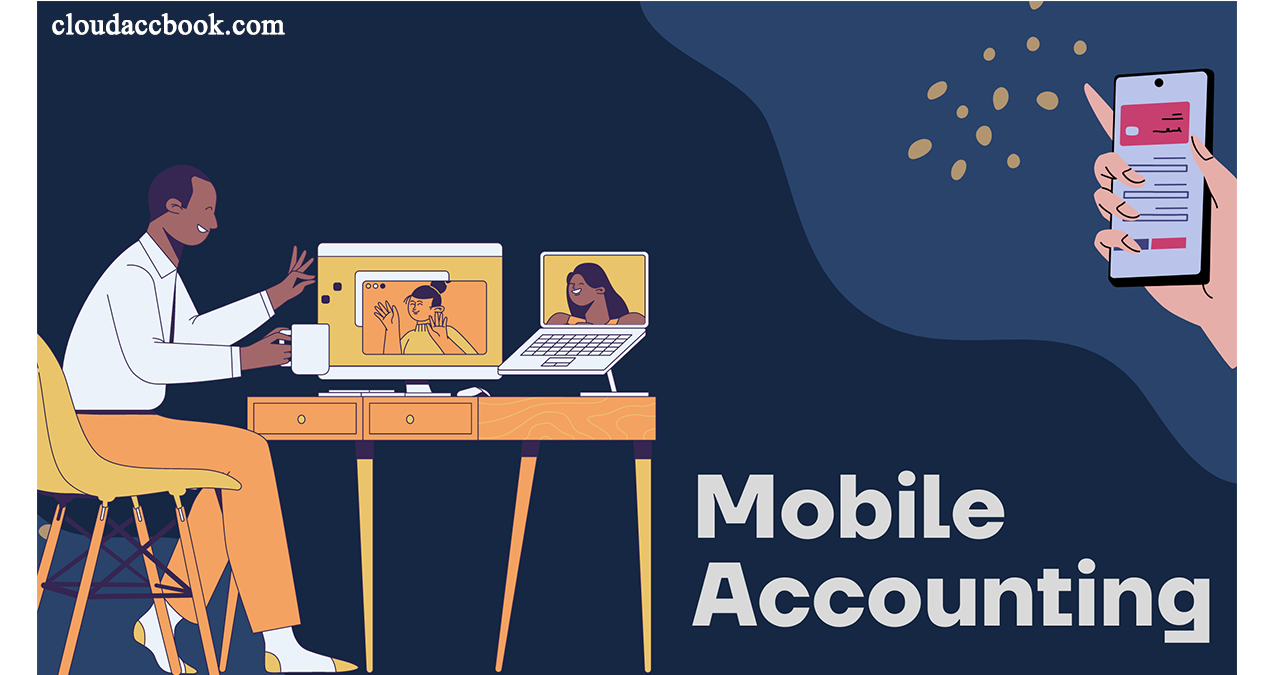What is Mobile Accounting?
The continuous evolution in technology is always opening new doors for the people who are constantly seeking efficient solutions for their day-to-day problems. In the beginning, accounting was recognized as a very tedious process and today, it is converting into a process that can be done by mobile phones from anywhere at any time.
People are interacting with mobile devices from the moment they woke up in the morning. Review42.com website mentioned that an average smartphone user will tap, click and swipe their phones 2,617 times each day and spend 2hrs and 51 mins on their mobile phones. Therefore, these jaw-dropping facts imply that the utilization of mobile devices to perform various accounting tasks will help companies to achieve high -efficiency levels while building simplified workflows and processes.
Mobile accounting refers to the use of portable devices like smart phones, tablets and laptops to access and process accounting, finance and or any other business – related data and information. It enables users to access information at their convenience and provides real-time information. Accounting software developers like Xero, QuickBooks, Sage have already created unique mobile applications for their users and there are many more applications in the market that can be easily downloaded as per your requirement.
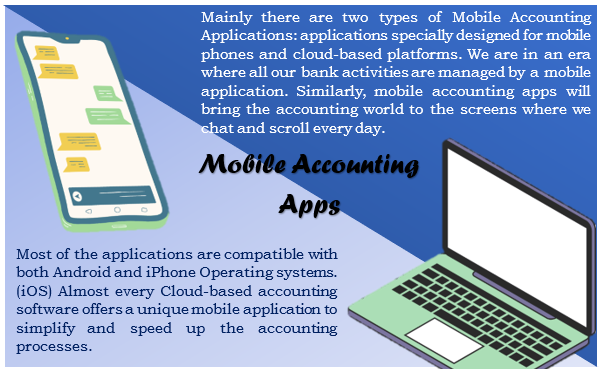
Uses of Mobile Accounting
1. Invoicing
Invoicing can be recognized as a mundane and time-consuming task that holds an important part in the accounting process. Accountants need to identify and record invoices accurately to collect the payments on time. By using mobile accounting customers or clients can directly send the invoices and estimates from anywhere at any time. Users can view summarized and customized reports and some applications even facilitate direct printing.
These invoices will be directly entered into the accounting system and always display real-time information. Further users can simply view the status of the invoices, notifications related to invoices and it also enables them to send automatic payment reminders to their clients. Most importantly, some applications allow users to create customized invoices even with multi-currency options. Finally, all these facilities will help companies to keep information-related to invoices at their fingertips.
2. Bank Reconciliation
Bank reconciliation is the process of matching a company’s financial records with its bank statement. It is simply about identifying missing items or unknown figures. Old days professionals used to perform manual reconciliation which took long hours and even days. But then the technological revolution automated reconciliation and moved it to cloud-based platforms and also it has integrated with third-party payment software to provide a great service.
However, today the accounting world is going beyond that and enables users to do reconciliations with a single tap on their mobile phones and some are even powered by AI technology. Therefore, this process will no longer be a time-consuming, mundane task.
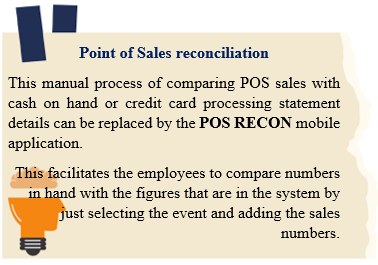
3. Expense management
Accounting professionals have to keep an eye on expenses regardless of the amount, as these figures can be manipulated easily. Accountants can act smart by using mobile accounting tools rather than spending hours and hours on checking the accuracy.
There is a wide variety of mobile and online applications that are built to fulfil different needs. However, most of the applications facilitate expense tracking, employee reimbursements, faster payments and generating valuable reports which can provide useful insights within a minute. These improved facilities can be used as a solution to expense reimbursement fraud as well.
Further, developers have even introduced online applications to manage petty cash easily. officeanywhere.io (Petty Cash) is the best example that facilitates petty cash tracking, real-time notifications, live dashboards etc. Optical Character Recognition technology (OCR) has added more value to mobile accounting by enabling automatic extraction of details in the bills and receipts.
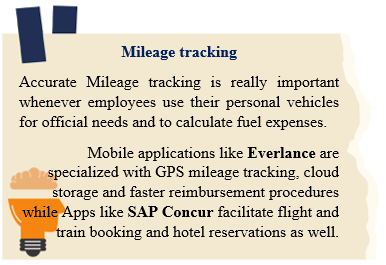
3. Live Dashboards
An accounting or financial dashboard visualizes the information related to Accounts Payable (different status of bills), Accounts receivables (invoices owed), cash inflows and outflows in different bank accounts, profit or loss details etc. Users can obtain useful information at a glance by these dashboards and it is even simpler with mobile apps. Further, the integration between StatX mobile dashboard and QuickBooks generates real-time information as it continuously gets updated with new additions and notifies users with messages even when the app is not in use. (pop up)
Most importantly, mobile applications like databox give snapshots about cash management (quick ratio, current ratio, cash balance), Financial KPIs (working capital, cash conversion cycle), Profit and Loss (gross profit margin, net profit margin, operating expense ratio) while datapine enables users to create unique, user-friendly dashboards which are rich with alerts, scorecards and even compatible with Apple Smartwatches.
4. Payroll
According to a study conducted by the American Payroll Association errors occurred due to manual procedures used in time and attendance tracking is amount to 1% – 7% of the total payroll cost. Further, its findings show that employees are spending an average of 7 minutes to reviewing a time sheet. Therefore, it is evident that valuable resources like time, money and labour are being wasted in the manual payroll processes.
Most companies are using semi-automated payroll systems which still require some amount of human intervention. Most importantly, mobile Apps like ZoHo People enables users to track attendance, manage timesheets, staff, leaves and handle file and documents while Apps like Fingercheck Time Clock address the problem of “Buddy Punching” (Co-worker punch a time card when the other employee is truly not there) by automatically taking a photo of the employees. (When punching)
Benefits of Mobile Accounting

Work from anywhere at anytime
As there is a silver lining in every dark cloud, the pandemic situation (Covid 19) has shown us the productive ways of working at home. According to the findings of a survey conducted by “Owl labs” each remote employee can save an average of 40 minutes per day which is spent on commuting and they are 22% more happier than the employees who visit the work locations daily.
Accounting professionals can maximize the benefit of fully remote workspaces or Hybrid workspaces by embracing mobile accounting and cloud-based technologies while ensuring work–life balance.

Save money and time
As per the statistics published on “THE WORLD COUNTS website” all most half of the waste produced by businesses is composed paper and teamstage.io mentioned that employees are wasting an average of 50 days on mundane tasks per year. Our unknown contribution to wastage production is clearly shown in these statistics. Users can save a considerable amount of money and time while saving the environment by adapting to cloud-based technologies and mobile accounting.
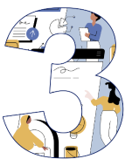
Increase efficiency with streamline processes
Some people see Digital transformation as a stepping stone to success while some have seen it as a step toward failure. “Smartsheet’s Automation in the workplace 2017” report stated that 80% of information workers believe that automation will help them to achieve efficiency in their day-to-day tasks while 66% of them believe it as a human error eliminator.
Employers need to identify the real need of the company and gather information about the available technologies to avoid unfavourable results. Most mobile accounting applications offer trial periods that can be used as experimental sessions. Accurate adoptions which are backed by informed decisions will eventually increase the overall productivity of the entities.

